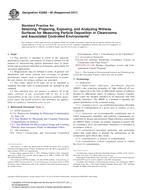Potřebujeme váš souhlas k využití jednotlivých dat, aby se vám mimo jiné mohly ukazovat informace týkající se vašich zájmů. Souhlas udělíte kliknutím na tlačítko „OK“.
ASTM E2217-12
Standard Practice for Design and Construction of Aerospace Cleanrooms and Contamination Controlled Areas
Automaticky přeložený název:
Standardní praxe pro design a konstrukce letecké a kosmické techniky čistých prostor a kontaminace oblastí kontrolovaných
NORMA vydána dne 1.4.2012
Informace o normě:
Označení normy: ASTM E2217-12
Poznámka: NEPLATNÁ
Datum vydání normy: 1.4.2012
Kód zboží: NS-44694
Počet stran: 14
Přibližná hmotnost: 42 g (0.09 liber)
Země: Americká technická norma
Kategorie: Technické normy ASTM
Kategorie - podobné normy:
Čisté prostory a příslušné řízené prostředí
Letadla a kosmické dopravní prostředky všeobecně
Anotace textu normy ASTM E2217-12 :
Keywords:
cleanroom, construction, design, spacecraft, test, Aerospace applications, Cleanrooms (materials/applications), Contamination--aerospace materials/applications, Design--aerospace applications, Spacecraft construction areas, ICS Number Code 13.040.35 (Cleanrooms and associated controlled environments), 49.020 (Aircraft and space vehicles in general)
Doplňující informace
| Significance and Use | ||||||||||||||||||||||
|
This practice describes and defines factors to be taken into consideration when designing and fabricating a cleanroom or controlled area that is used for aerospace operations and fabrication. Following the suggestions herein should provide a facility that is more capable of meeting performance requirements and that will offer protection against contamination for objects fabricated and processed in such a facility. |
||||||||||||||||||||||
| 1. Scope | ||||||||||||||||||||||
|
1.1 The purpose of this practice is to provide design and construction guidelines for contamination controlled facilities used in the assembly and integration of aerospace hardware. The guidelines herein are intended to ensure that the facilities, when used properly, will meet the cleanliness requirements of aerospace hardware and processes. The objective is to limit contamination due to the deposition of particulate and molecular contaminants on flight hardware surfaces. 1.2 One cleanliness classification of a facility is the airborne particle concentrations in accordance with ISO 14644-1 and 14644-2. Airborne particle concentrations in accordance with FED-STD-209E are included for reference. This simple classification is inadequate to describe a facility that will support the assembly and integration of spacecraft. The extended duration of hardware exposure during fabrication and testing, the sensitivity of the hardware to hydrocarbons and other molecular contaminants, and the changing requirements during assembly and integration must be considered in addition to the airborne particle concentrations. 1.3 The guidelines specified herein are intended to provide facilities that will effectively restrict contaminants from entering the facility, limit contamination generated by and within the facility, and continuously remove airborne contaminants generated during normal operations. Some items of support hardware, such as lifting equipment, stands, and shoe cleaners, are addressed since these items are often purchased and installed with the facility and may require accommodation in the design of the facility. 1.4 Active filtration of molecular contaminants (such as hydrocarbons, silicones, and other chemicals) is discussed. Such active filtration of molecular contaminants may be required for the processing of highly sensitive optical devices, especially infrared and cryogenic sensors. Control of microbiological contamination is not included although HEPA (High Efficiency Particulate Air) filtration will provide some control of airborne bacteria, spores, and other viable contaminants that are typically carried on particles of sizes 0.3 μm and larger. Control of radioactive contamination and accommodation of very hazardous materials such as propellants, strong acids or caustics, or carcinogens are not addressed. 1.5 No facility will compensate for excessive contamination generated inside the facility. In addition to an effective facility design, the user must also institute a routine maintenance program (see Practice E2042) for the facility, and personnel and operational disciplines that limit the transfer of contaminants through entry doors and contaminant generation inside the facility. 1.6 This practice only addresses guidelines for contamination control in facility design. It must be implemented in compliance with all mandatory government and regulatory building and safety codes. References to related cleanroom standards and U.S. building codes and standards may be found in IEST-RP-CC012. 1.7 The values stated in SI units are to be regarded as standard. No other units of measurement are included in this standard. 1.7.1 The values given in parentheses are provided for information only and are not considered standard. 1.8 This standard does not purport to address all of the safety concerns, if any, associated with its use. It is the responsibility of the user of this standard to establish appropriate safety and health practices and determine the applicability of regulatory limitations prior to use. |
||||||||||||||||||||||
| 2. Referenced Documents | ||||||||||||||||||||||
|
Podobné normy:
Historická
1.4.2009
Historická
1.9.2011
Historická
1.4.2012
Historická
1.1.2011
Historická
1.4.2010
Historická
1.4.2008
Doporučujeme:
Aktualizace technických norem
Chcete mít jistotu, že používáte pouze platné technické normy?
Nabízíme Vám řešení, které Vám zajistí měsíční přehled o aktuálnosti norem, které používáte.
Chcete vědět více informací? Podívejte se na tuto stránku.



 ASTM E2042/E2042M-09..
ASTM E2042/E2042M-09.. ASTM E2088-06(2011)..
ASTM E2088-06(2011).. ASTM E2090-12
ASTM E2090-12 ASTM E2312-11
ASTM E2312-11 ASTM E2352-04(2010)..
ASTM E2352-04(2010).. ASTM E2614-08
ASTM E2614-08
 Cookies
Cookies
